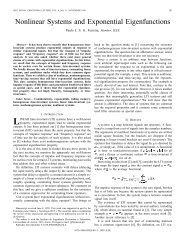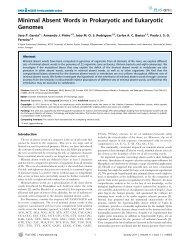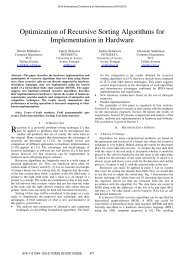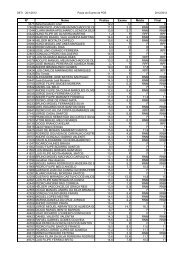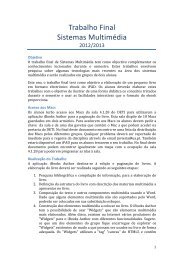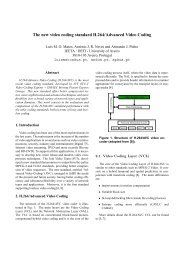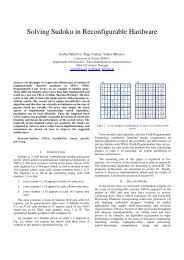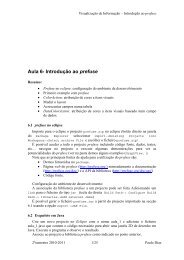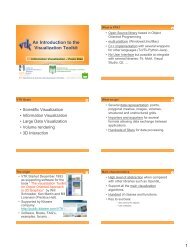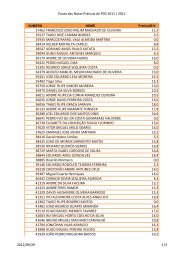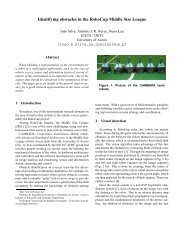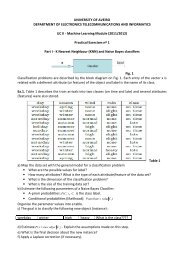Reuse Technique in Hardware Design - Sweet
Reuse Technique in Hardware Design - Sweet
Reuse Technique in Hardware Design - Sweet
You also want an ePaper? Increase the reach of your titles
YUMPU automatically turns print PDFs into web optimized ePapers that Google loves.
<strong>Reuse</strong> <strong>Technique</strong> <strong>in</strong> <strong>Hardware</strong> <strong>Design</strong><br />
Valery Sklyarov, Iouliia Skliarova<br />
University of Aveiro, Department of Electronics, Telecommunications and Informatics, IEETA<br />
3810-193 Aveiro, Portugal<br />
skl@det.ua.pt, iouliia@det.ua.pt<br />
Abstract<br />
The paper presents a technique for the design of<br />
digital systems on the basis of reusable hardware<br />
templates, which are circuits with modifiable<br />
functionality that might be customized to satisfy<br />
requirements of target applications, such as a highly<br />
optimized implementation of the selected problem-specific<br />
operations. Reusability is provided at two levels that are<br />
the level of hardware circuits and the level of<br />
specifications. The paper demonstrates how hardware<br />
templates can be modeled <strong>in</strong> software and implemented <strong>in</strong><br />
hardware.<br />
1. Introduction<br />
Tremendous progress <strong>in</strong> the scope of fieldprogrammable<br />
gate array (FPGA) technology has made it<br />
possible to advance configurable microchips from simple<br />
gate arrays that appeared on the market <strong>in</strong> the mid-1980s<br />
to multi-platform FPGAs conta<strong>in</strong><strong>in</strong>g more than 10 million<br />
system gates and targeted to the design of very<br />
complicated eng<strong>in</strong>eer<strong>in</strong>g systems. Today, the way to<br />
evolve higher performance comput<strong>in</strong>g from a generalpurpose<br />
computer, proposed more than 45 years ago [1],<br />
has been f<strong>in</strong>ally implemented <strong>in</strong> reality. The market for<br />
FPGAs and other programmable logic devices is expected<br />
to grow from $3.2 billion <strong>in</strong> 2005 to $6.7 billion <strong>in</strong> 2010<br />
[2]. An analysis presented <strong>in</strong> [3] clearly demonstrates that<br />
the largest FPGA consumers will be <strong>in</strong> eng<strong>in</strong>eer<strong>in</strong>g with<br />
numerous applications <strong>in</strong> the scope of electronic system<br />
design, from glue logic to high-complexity application<br />
specific (ASIC-type) devices. Pioneer<strong>in</strong>g products such as<br />
Xil<strong>in</strong>x’s Virtex [4] or Altera’s Stratix [5] FPGA families<br />
will f<strong>in</strong>d their ma<strong>in</strong> applications <strong>in</strong> the development of<br />
high-volume products.<br />
Develop<strong>in</strong>g eng<strong>in</strong>eer<strong>in</strong>g systems on the basis of high<br />
capacity FPGAs puts forward a fundamental question –<br />
how to cope with rapidly grow<strong>in</strong>g complexity, or, <strong>in</strong> other<br />
words, how to use efficiently enormous and cont<strong>in</strong>uously<br />
ris<strong>in</strong>g hardware resources <strong>in</strong> the design process? This is<br />
actually very important because accord<strong>in</strong>g to the Moore’s<br />
law [6] every two years the density of microelectronic<br />
devices is generally doubled permitt<strong>in</strong>g at the same time<br />
better performance, and improved features. Fig. 1<br />
demonstrates the relevancy of this law to static memory,<br />
Xil<strong>in</strong>x FPGAs [7] and Intel processors [6]. As we can see<br />
from Fig. 1 chip complexity grows exponentially with<br />
time. But what is important is that the number of available<br />
transistors grows faster than the ability to mean<strong>in</strong>gfully<br />
design with them. This situation is a well known design<br />
productivity gap, which was <strong>in</strong>herited by FPGA from<br />
ASIC and which is <strong>in</strong>creas<strong>in</strong>g cont<strong>in</strong>uously. Therefore the<br />
design productivity will be the real challenge for future<br />
systems.<br />
Number of transistors ×10 8<br />
11<br />
10<br />
9<br />
8<br />
7<br />
6<br />
5<br />
4<br />
3<br />
2<br />
1<br />
64M<br />
256M<br />
1G<br />
Static memories<br />
Virtex-E<br />
Virtex<br />
Virtex-II<br />
Virtex-IIPro<br />
FPGAs<br />
Processors<br />
Virtex-4-5<br />
Pentium 4<br />
Dual core<br />
Itanium 2 (9MB cache)<br />
Itanium 2<br />
1990 2000 2010<br />
Year<br />
Fig. 1. Relevancy of the Moore's law to different<br />
microelectronics products<br />
One possible answer to the above question is to apply<br />
a reuse technique and an evolutionary strategy <strong>in</strong> such a<br />
way that permits parameterizable and highly optimized<br />
project components to be <strong>in</strong>volved once aga<strong>in</strong> <strong>in</strong> future<br />
projects. Thus, the exist<strong>in</strong>g experience might be<br />
powerfully <strong>in</strong>tegrated <strong>in</strong> the future products.
The majority of available synthesis tools permit to<br />
construct circuits, which, <strong>in</strong> general, cannot be reused.<br />
Any desired modification to the circuit functionality<br />
requires repeat<strong>in</strong>g the synthesis from the beg<strong>in</strong>n<strong>in</strong>g,<br />
<strong>in</strong>clud<strong>in</strong>g debugg<strong>in</strong>g, test<strong>in</strong>g and other steps that are<br />
considered as a part of the design process. This procedure<br />
can be significantly simplified with the aid of fieldprogrammable<br />
technology (such as that is implemented <strong>in</strong><br />
FPGAs) but <strong>in</strong> any case it requires additional time and<br />
high-experienced human resources. The paper shows that<br />
for some practical applications the considered problem<br />
can be alleviated. It might be achieved for digital systems<br />
that can be decomposed <strong>in</strong> a reusable core (which is<br />
extendable <strong>in</strong> general case) and a reprogrammable control<br />
unit(s). The latter can be modeled by a reprogrammable<br />
f<strong>in</strong>ite state mach<strong>in</strong>e (RFSM). The proposed design<br />
method is based on reusable hardware templates (HT).<br />
The HT is a circuit with predef<strong>in</strong>ed structure that has<br />
already been implemented <strong>in</strong> hardware (for example, <strong>in</strong><br />
FPGA). The basic components of the circuit are RAMblocks,<br />
and by reprogramm<strong>in</strong>g them we can implement<br />
different functionality. This might be done with the aid of<br />
an additional removable component of the designed<br />
system called reconfiguration controller, which can be<br />
used, <strong>in</strong> particular, just for debugg<strong>in</strong>g purposes. It makes<br />
possible to evaluate various alternatives to the<br />
functionality of the developed system avoid<strong>in</strong>g many<br />
traditional steps of digital design that are time and<br />
resource consum<strong>in</strong>g.<br />
The rema<strong>in</strong>der of the paper is organized <strong>in</strong> five<br />
sections. Section 2 makes an overview of available design<br />
specification methods and discusses the future of<br />
reconfigurable systems. Section 3 is devoted to hardware<br />
templates and their potentialities. Section 4 describes the<br />
proposed reuse technique for hardware design. The<br />
conclusion is given <strong>in</strong> Section 5.<br />
2. The present and the future of<br />
reconfigurable systems<br />
<strong>Design</strong>ers of FPGA-based systems must wade through<br />
several layers of design before programm<strong>in</strong>g the actual<br />
device. The typical FPGA flow <strong>in</strong>cludes the follow<strong>in</strong>g<br />
major phases, which are design entry, synthesis, mapp<strong>in</strong>g,<br />
placement and rout<strong>in</strong>g, FPGA programm<strong>in</strong>g, and<br />
verification. The latter can occur at different levels such<br />
as behavioral simulation, functional simulation, static<br />
tim<strong>in</strong>g analysis, post-layout tim<strong>in</strong>g simulation and,<br />
f<strong>in</strong>ally, <strong>in</strong>-circuit verification. If we focus our attention on<br />
the design entry, four different specification methods can<br />
be envisioned, which are schematic entry, hardware<br />
description languages, system-level specification<br />
languages and, f<strong>in</strong>ally, general-purpose programm<strong>in</strong>g<br />
languages.<br />
The schematic-based approach is nowadays not very<br />
appropriate for specify<strong>in</strong>g the functionality of modern<br />
systems because <strong>in</strong>stead of th<strong>in</strong>k<strong>in</strong>g <strong>in</strong> terms of<br />
algorithms and data structures it forces the designer to<br />
deal directly with the hardware components and their<br />
<strong>in</strong>terconnections. Contrariwise, the hardware description<br />
languages - HDLs (such as VHDL and Verilog) are<br />
widely used for design specification s<strong>in</strong>ce they typically<br />
<strong>in</strong>clude facilities for describ<strong>in</strong>g structure and functionality<br />
at a number of levels, from the more abstract algorithmic<br />
level down to the gate level.<br />
Recently, commercial tools allow<strong>in</strong>g digital circuits to<br />
be synthesized from system-level specification languages<br />
(SLSL), such as Handel-C and SystemC, have appeared<br />
on the market. This fact allows the designer to work at a<br />
very high level of abstraction, virtually without worry<strong>in</strong>g<br />
about how the underly<strong>in</strong>g computations are executed.<br />
Consequently, even computer eng<strong>in</strong>eers with a limited<br />
knowledge of the targeted FPGA architecture are capable<br />
of produc<strong>in</strong>g rapidly functional, algorithmically<br />
optimized designs.<br />
Even higher level of abstraction is achieved with<br />
general-purpose programm<strong>in</strong>g languages (GPPL), such as<br />
C++ or Java. Dur<strong>in</strong>g the last year commercial tools (for<br />
<strong>in</strong>stance, Catapult Synthesis from Mentor Graphics and<br />
CoDeveloper from Impulse) started appear<strong>in</strong>g on the<br />
market allow<strong>in</strong>g the respective high-level descriptions to<br />
be transformed automatically to an HDL, which is further<br />
used for synthesis. In this case the code portions that can<br />
be executed <strong>in</strong> parallel are identified automatically by the<br />
design tools.<br />
Besides of the mentioned design specification<br />
methods there exist other opportunities such as vendor<br />
libraries, graphical f<strong>in</strong>ite state mach<strong>in</strong>e editors,<br />
parameterizable IP (<strong>in</strong>tellectual property) cores and so on.<br />
In Fig. 2 different design specification methods are<br />
assessed accord<strong>in</strong>g to such criteria as performance, FPGA<br />
resource usage, portability, ease to learn, ease to change<br />
and ma<strong>in</strong>tenance and, f<strong>in</strong>ally, the development time (<strong>in</strong><br />
the first five groups of vertical bars the higher is the<br />
better, and for the last group the lower is the bar the better<br />
is the respective method).<br />
From the graph we can see that schematic-based<br />
approach allows circuits with very good performance and<br />
efficient resource usage to be created. However, when we<br />
speak about portability and ease to learn, change and<br />
ma<strong>in</strong>tenance and the associated development time,<br />
schematic entry is an obvious outsider. As it was noticed<br />
<strong>in</strong> a recent EE Times survey “The days of design<strong>in</strong>g<br />
FPGA with schematics are gone.” [8].<br />
<strong>Hardware</strong> description languages are currently the<br />
golden mean of the design entry methods. They allow<br />
creat<strong>in</strong>g high-performance circuits, optimized from the<br />
resource usage po<strong>in</strong>t of view, the development time is not<br />
so long and provid<strong>in</strong>g changes to the design is not very
difficult. The only weak po<strong>in</strong>t is that HDLs are not so<br />
easy to learn.<br />
3<br />
5<br />
2<br />
5<br />
5<br />
0<br />
performance resource usage portability ease to learn ease to change<br />
and<br />
ma<strong>in</strong>ta<strong>in</strong>ance<br />
development<br />
time<br />
Schematic<br />
HDL<br />
SLSL<br />
GPPL<br />
Fig. 2. Comparison of specification methods<br />
Obviously, system-level and high-level languages<br />
possess the best portability and the highest level of<br />
abstraction. Of course, the higher level of abstraction<br />
leads to some performance degradation and not very<br />
efficient resource usage. On the other hand SLSLs and<br />
GPPLs have many advantages such as ease to learn, ease<br />
to change and ma<strong>in</strong>tenance, and a very short development<br />
time. Therefore, we can expect that as the tools<br />
responsible for generat<strong>in</strong>g hardware (more specifically,<br />
either an EDIF – electronic design <strong>in</strong>terchange format file<br />
or an HDL file) from high-level source code advance, the<br />
SLSLs and GPPLs may become the predom<strong>in</strong>ant<br />
hardware description methodology, <strong>in</strong> the same way as<br />
general-purpose high-level programm<strong>in</strong>g languages have<br />
already supplanted microprocessor assembly languages.<br />
In order to <strong>in</strong>crease the design productivity the<br />
follow<strong>in</strong>g challenges must be met. First of all, design<br />
reuse must be encouraged. Reusable high-level functional<br />
blocks (such as IP blocks) offer great potential for<br />
productivity ga<strong>in</strong>s because design effort for the reused<br />
logic is only a portion of the effort needed for newly<br />
designed logic. Accord<strong>in</strong>g to ITRS, it is expected that<br />
reuse rate for system-level design will <strong>in</strong>crease from 32%<br />
<strong>in</strong> 2005 to 55% <strong>in</strong> 2020 [9].<br />
Second, reuse techniques have to be <strong>in</strong>corporated <strong>in</strong><br />
the synthesis process. In other words, as soon as we want<br />
to apply synthesis tools to construct a new circuit, these<br />
tools have to predict how different components of the<br />
circuit can be reused <strong>in</strong> the future products. Note, that if<br />
reuse techniques applied at the level of entire blocks<br />
(such as IP cores and design libraries) are widely<br />
employed, the same techniques at the level of synthesis<br />
process are not developed at all. The paper is <strong>in</strong>tended to<br />
present some results <strong>in</strong> the scope of synthesis reuse and to<br />
demonstrate some benefits that can be obta<strong>in</strong>ed.<br />
The third po<strong>in</strong>t is that design abstraction levels must<br />
be raised. Higher levels of abstraction allow many forms<br />
of verification to be performed much earlier <strong>in</strong> the design<br />
process, reduc<strong>in</strong>g lead-time to market and lower<strong>in</strong>g cost<br />
by discover<strong>in</strong>g problems earlier [10]. We have already<br />
mentioned that tools are currently emerg<strong>in</strong>g allow<strong>in</strong>g for<br />
hardware design at a very high level of abstraction. Thus<br />
synthesis reuse techniques have to be adapted to different<br />
levels.<br />
And f<strong>in</strong>ally, the fourth po<strong>in</strong>t is to <strong>in</strong>crease the level of<br />
automation which <strong>in</strong>evitably will allow the number of<br />
design iterations to be reduced. In case of platform-based<br />
design, further improvements <strong>in</strong> automated<br />
software/hardware partition<strong>in</strong>g tools are strongly<br />
required.<br />
Now it is clear, that reconfigurability will certa<strong>in</strong>ly be<br />
the key aspect of future systems s<strong>in</strong>ce it will be needed<br />
for fault tolerance, for example, <strong>in</strong> molecular-scale<br />
systems, and for development of adaptive and selfcorrect<strong>in</strong>g<br />
or self-repair<strong>in</strong>g circuits. In addition,<br />
reconfigurability itself <strong>in</strong>creases reuse, s<strong>in</strong>ce exist<strong>in</strong>g<br />
devices can be reprogrammed to fulfill new tasks.<br />
Accord<strong>in</strong>g to ITRS forecast more and more SOC<br />
functionality will become reconfigurable [10].<br />
3. <strong>Hardware</strong> templates<br />
In general, hardware templates can be seen as reusable<br />
blocks at the circuit level. FPGAs are microelectronic<br />
devices that can be reused <strong>in</strong> such a way that the same<br />
microchip can implement different types of functionality.<br />
This is achieved through upload<strong>in</strong>g a reconfiguration<br />
bitstream to FPGA’s static memory, which customizes the<br />
FPGA hardware for the required project. On the contrary,<br />
the HT is a customizable circuit that has already been<br />
implemented <strong>in</strong> an FPGA. In other words the FPGA has<br />
been already configured but it still can be reconfigured<br />
through reprogramm<strong>in</strong>g some blocks of the HT. This<br />
permits, <strong>in</strong> particular, to reduce reconfiguration time<br />
significantly and to keep all predef<strong>in</strong>ed tim<strong>in</strong>g constra<strong>in</strong>ts<br />
<strong>in</strong> hardware circuits.<br />
Thus, on the one hand any HT is an applicationspecific<br />
circuit but on the other hand it can be customized<br />
enabl<strong>in</strong>g us to implement different functionality, which is<br />
provided <strong>in</strong> such a way that basic characteristics of the<br />
circuit (such as the longest path delay) are optimized.<br />
A general architecture of HT depends on the selected<br />
application-specific area. For example, templates might<br />
be constructed for different operations over b<strong>in</strong>ary and<br />
ternary vectors, for reprogrammable <strong>in</strong>terfaces between<br />
digital circuits, for specific computational algorithms, etc.<br />
Suppose we have to solve some tasks from a given<br />
area. For example, we want to construct a template for<br />
circuits that implement different types of <strong>in</strong>terfaces. Note<br />
that the basic operations for such type of applications are<br />
very similar but on the other hand each particular<br />
<strong>in</strong>terface might be unique. In order to model a template<br />
and to implement it <strong>in</strong> hardware the follow<strong>in</strong>g technique<br />
has been employed. Initially the considered problem is<br />
studied <strong>in</strong> detail and the basic HT architecture is
proposed. This architecture has to be able to implement<br />
all the desired functionalities (all the required <strong>in</strong>terfaces<br />
for our example). On the other hand it has to be built <strong>in</strong><br />
such a way that it can be optimized for any particular<br />
functionality that is needed for the considered device. In<br />
other words, we would like to be able to personalize and<br />
to optimize this architecture for any customized circuit<br />
that belongs to the selected application-specific area. At<br />
the second step, the HT has to be implemented and tested<br />
<strong>in</strong> software. This allows to validate its correctness and to<br />
analyze its effectiveness for solv<strong>in</strong>g various particular<br />
tasks. At the next step, the template has to be<br />
implemented and verified <strong>in</strong> hardware. F<strong>in</strong>ally, we can<br />
use the HT for solv<strong>in</strong>g problems from the selected area.<br />
It is very important that there exists a personalization<br />
of HT implementations from “more targeted to software<br />
specifications” to “more targeted to hardware<br />
specifications”. Thus, relationships between different<br />
levels of hardware specifications considered <strong>in</strong> the<br />
previous sections can easily be established. Indeed,<br />
mutual <strong>in</strong>terdependence of the levels enables the<br />
designers to achieve a number of advantages, such as the<br />
follow<strong>in</strong>g:<br />
• Specification of the HT can be done at any desired<br />
level, i.e. general-purpose language, system-level<br />
specification language and hardware description<br />
language.<br />
• S<strong>in</strong>ce there exists software implementation of HT, all<br />
the required configurations can be generated, debugged<br />
and tested <strong>in</strong> general-purpose computer and prepared for<br />
future upload<strong>in</strong>g to the relevant hardware.<br />
• There exists an opportunity of run-time<br />
reconfiguration (reprogramm<strong>in</strong>g HT blocks), which is a<br />
very challeng<strong>in</strong>g feature for virtual adaptive systems.<br />
In order to provide a more compact software HT<br />
model we will use an object-oriented description<br />
proposed <strong>in</strong> [11] with the aid of C++ classes (see Fig. 3).<br />
The top-level specification <strong>in</strong>cludes just two classes that<br />
are an abstract class datapath_template and a concrete<br />
class FSM_template. Note that the datapath <strong>in</strong> Fig. 3 can<br />
also <strong>in</strong>clude a similar HT of a lower level.<br />
It is assumed that the problem can be solved with the<br />
aid of the function Solve, which executes an algorithm<br />
described by the argument FSM_template&. An<br />
<strong>in</strong>teraction between the classes datapath_template and<br />
FSM_template has been organized through the functions<br />
Run <strong>in</strong> such a way that the function<br />
FSM_template::Run(X) takes arguments presented <strong>in</strong> the<br />
<strong>in</strong>put vector X and returns outputs <strong>in</strong> form of vector Y;<br />
the function datapath_template::Run(Y) takes arguments<br />
presented <strong>in</strong> the vector Y and returns outputs <strong>in</strong> form of<br />
vector X.<br />
The class datapath_template describes a general<br />
structure of hardware that can be used for solv<strong>in</strong>g an<br />
application-specific subset of tasks. The functions Solve<br />
and Run are pure virtual functions because we <strong>in</strong>tend to<br />
model just a general structure for a subset of similar tasks<br />
and we do not have yet any particular implementation.<br />
The latter can be described by a concrete class derived<br />
from the class datapath_template <strong>in</strong> such a way that the<br />
considered above general structure is either reused<br />
without any change or extended. In order to solve<br />
different problems with the aid of the same datapath<br />
(execution unit) we have to be able to change the<br />
sequence of operations that is generated by control<br />
circuits, i.e. we have to alter the behavior of the<br />
respective RFSM(s). It is important to provide such<br />
modifications not only for software model (which is<br />
flexible by def<strong>in</strong>ition), but also for the relevant hardware<br />
model. The latter is proposed <strong>in</strong> [11] and synthesis of<br />
RFSM can be done with the aid of methods [12]. In<br />
general, an RFSM is composed of two blocks (see fig. 3):<br />
a RAM-based core with customizable behavior, and a<br />
controller, which permits to configure the core <strong>in</strong> such a<br />
way that enables us to implement the desired particular<br />
behavior.<br />
C++ model<br />
<strong>Hardware</strong> model<br />
class datapath_template<br />
{ public:<br />
datapath_template();<br />
virtual unsigned Run(unsigned Y)= 0;<br />
virtual unsigned Solve(FSM_template&)=0;<br />
// ..... other functions<br />
};<br />
Y<br />
class FSM_template<br />
{ public:<br />
FSM_template(<strong>in</strong>t L, <strong>in</strong>t R, <strong>in</strong>t N, <strong>in</strong>t G,<br />
/*memory specification*/)<br />
unsigned Run(unsigned X);<br />
void Reload(/*memory specification*/);<br />
void Switch(/*memory segment*/);<br />
};<br />
These functions permit to<br />
change the FSM functionality<br />
X<br />
This function executes a state<br />
transition and generates outputs<br />
DATAPATH<br />
Y<br />
RFSM core<br />
X<br />
RFSM<br />
Controller, which permits the<br />
RFSM behavior to be changed<br />
Fig. 3. Relationship between software and<br />
hardware models<br />
The functions Run and Solve can properly be<br />
described after we study a specific class of applications.<br />
For example, let us exam<strong>in</strong>e comb<strong>in</strong>atorial search<br />
algorithms formulated over b<strong>in</strong>ary and ternary matrices,<br />
such as matrix cover<strong>in</strong>g, the Boolean satisfiability, graph<br />
color<strong>in</strong>g, etc. It is known that the execution unit<br />
(datapath) for such algorithms can be constructed <strong>in</strong> such<br />
a way that it will be common for different problems [13].<br />
Customization of operations for the concrete problem can<br />
be done through modification of control algorithms<br />
implemented <strong>in</strong> the respective control unit (which is the<br />
RFSM). All the required details and examples of such<br />
customization are presented <strong>in</strong> [13]. The same technique<br />
can be applied to other problems, such as sort<strong>in</strong>g and<br />
order<strong>in</strong>g algorithms [14], data compression/<br />
decompression algorithms [15], etc. Note that for the
design of reprogrammable control units the exist<strong>in</strong>g<br />
methods [12] can directly be used. The specification of<br />
control algorithms can be provided with the aid of a<br />
graphical language called hierarchical graph schemes<br />
(HGS) [16], which supports modular and hierarchical<br />
mechanisms implemented <strong>in</strong> the respective model of<br />
f<strong>in</strong>ite state mach<strong>in</strong>e (FSM), called hierarchical FSM<br />
(HFSM). For a number of practical applications HGS can<br />
easily be constructed from specifications <strong>in</strong> generalpurpose<br />
languages, such as C/C++ [12]. Any HGS<br />
provides support for: modularity (each <strong>in</strong>dividual HGS is<br />
considered to be a module that, <strong>in</strong> general, can be reused);<br />
hierarchy and parallelism. It is known that HGS can be<br />
formally translated to the respective control circuits<br />
modeled by HFSM [16] and described by a hardware<br />
template [14]. The latter is composed of two concurrently<br />
execut<strong>in</strong>g VHDL processes. The first process describes<br />
two stacks that are needed to keep codes of modules<br />
(M_stack) and states (FSM_stack) <strong>in</strong> each module. The<br />
second one specifies functionality of comb<strong>in</strong>ational<br />
circuit which def<strong>in</strong>es transitions between the modules and<br />
the states. The dist<strong>in</strong>ctive feature of HFSMs (compar<strong>in</strong>g<br />
with traditional FSMs) is the ability to provide state<br />
transitions at the follow<strong>in</strong>g two levels:<br />
• At the first level the code of the top register of<br />
M_stack enables the process to recognize the module.<br />
• At the second level the code of the top register of<br />
FSM_stack and values of external <strong>in</strong>put variables (from<br />
the set X = {x 1 ,…,x L }) enable the process to recognize<br />
the proper state transition, i.e. to form the code of the next<br />
state (and/or) the code of the next module. Obviously, the<br />
states with<strong>in</strong> different modules might have the same<br />
codes and all the states with<strong>in</strong> the same module must have<br />
different codes.<br />
The relevant synthesis and implementation details are<br />
described <strong>in</strong> [14] with examples of VHDL specifications<br />
for practical problems.<br />
It is important to note that all VHDL constructions<br />
[14] can easily be replaced with equivalent constructions<br />
for system-level specification languages, such as Handel-<br />
C, and they are reusable and synthesizable, i.e. they can<br />
be automatically converted to the respective hardware<br />
circuits. Thus, the same functionality can easily be<br />
modeled <strong>in</strong> any language, i.e. general-purpose languages,<br />
system-level specification languages and hardware<br />
description languages. This is important because different<br />
specifications can be used with<strong>in</strong> the same project (see<br />
section 2). As dist<strong>in</strong>ct from HTs for execution units, the<br />
considered HTs for control units can be seen as blocks<br />
allow<strong>in</strong>g reusability at the specification level. Comb<strong>in</strong><strong>in</strong>g<br />
capabilities of reconfigurable and hierarchical FSMs we<br />
can construct such a control unit which <strong>in</strong>tegrates<br />
reusability of hardware circuits with reusability of<br />
algorithms. Indeed, the comb<strong>in</strong>ational circuit of an HFSM<br />
can be built from RAM blocks <strong>in</strong> such a way that the<br />
method [12] can be applied without any change. F<strong>in</strong>ally,<br />
the same circuit is able to implement different<br />
functionalities. Us<strong>in</strong>g the template [14] we can construct<br />
a reconfigurable hierarchical FSM (RHFSM), which<br />
supports reusability at the level of algorithms (subalgorithms)<br />
much like as for software development (i.e.,<br />
for example, much like reusability of functions <strong>in</strong> C/C++<br />
language). Thus, we can construct control circuits<br />
allow<strong>in</strong>g to change their behavior based on RFSM model<br />
and to assemble algorithms from previously designed and<br />
tested algorithmic blocks with the aid of HFSM model.<br />
4. Reusability <strong>in</strong> hardware design<br />
Fig. 4 summarizes the proposed reuse technique <strong>in</strong><br />
hardware design. At the topmost level, the circuit is<br />
considered to be a decomposition of an execution unit<br />
(datapath) and a control unit communicat<strong>in</strong>g through predef<strong>in</strong>ed<br />
reusable <strong>in</strong>terface.<br />
Customizable<br />
execution unit<br />
(datapath)<br />
Reusable hardware template<br />
for solv<strong>in</strong>g particular problems<br />
Y X<br />
RFSM<br />
x<br />
y 0 Y y N-1 x 0<br />
Output<br />
RAM<br />
X<br />
L-1<br />
M<br />
RAM<br />
fdc 0<br />
Reconfigurable 0<br />
Hierarchical RAM FSM<br />
R-1<br />
fdc R-1<br />
G blocks<br />
Controller, which permits the<br />
RFSM behavior to be changed<br />
Reprogrammable<br />
control unit<br />
x 1<br />
x L<br />
next<br />
state<br />
M_stack<br />
Comb<strong>in</strong>ational<br />
circuit (CC)<br />
FSM_stack<br />
y 1 y N<br />
current<br />
state<br />
Enables us to implement hierarchical Beg<strong>in</strong><br />
algorithms with reusable modules<br />
Customization is achieved<br />
through the RFSM model<br />
1<br />
z 1<br />
0 1<br />
z 2<br />
x 1 y 4<br />
z 3<br />
Reusable<br />
modules<br />
Fig. 4. Summary of the proposed reuse<br />
technique for hardware design<br />
The follow<strong>in</strong>g methods have to be applied at the level<br />
of synthesis:<br />
1. The execution unit is made customizable for a<br />
selected group of closely related problems. The respective<br />
customization methods are known and they have already<br />
been considered for different hardware circuits, such as<br />
comb<strong>in</strong>atorial accelerators [13], etc. (many examples can<br />
be found <strong>in</strong> [13-15]).<br />
2. The reprogrammable control circuit is considered to<br />
be an RHFSM with customizable behavior, which:<br />
a) Permits to use the same hardware for different<br />
algorithms;<br />
b) Can <strong>in</strong>voke reusable modules.<br />
3. The RHFSM is constructed on the basis of the<br />
hardware template for HFSM [12,14].<br />
Based on HFSM<br />
y 1,y 2,y 3<br />
x 1<br />
0<br />
Beg<strong>in</strong><br />
Similar models for different specifications
4. Customization of RHFSM functionality is achieved<br />
through reload<strong>in</strong>g its RAM blocks with the aid of<br />
methods [12].<br />
5. Reusability of modules can be provided apply<strong>in</strong>g the<br />
same technique which is widely employed <strong>in</strong> software<br />
eng<strong>in</strong>eer<strong>in</strong>g.<br />
6. The considered models can be retargeted to any<br />
desired level of specification, such as general-purpose<br />
languages, system-level specification languages and<br />
hardware description languages. Thus, any design flow<br />
discussed <strong>in</strong> section 2 can be supported.<br />
7. Software models enable the designers to use generalpurpose<br />
computers to generate customization bitstreams<br />
and to verify the projects.<br />
The follow<strong>in</strong>g list summarizes advantages of the<br />
proposed reuse technique for hardware design:<br />
• It permits to realize highly optimized and carefully<br />
tested design templates for vast varieties of similar<br />
problems.<br />
• The designed circuits can be made adaptable to<br />
different external conditions. Indeed, dependently on<br />
external events the circuit can be properly modified,<br />
select<strong>in</strong>g an adequate module.<br />
• The designed circuits can be made virtual <strong>in</strong> such a<br />
way that we can implement functionality <strong>in</strong> FPGA that<br />
does not possess sufficient hardware resources. This can<br />
be achieved through proper sequential reconfiguration,<br />
which is allowed for the considered models.<br />
5. Conclusion<br />
The paper describes a reuse technique that can be<br />
applied to the design of FPGA-based, application-specific<br />
digital systems. Reusability is achieved at the follow<strong>in</strong>g<br />
two levels. First, the considered circuits (hardware<br />
templates) can be constructed <strong>in</strong> such a way that allows<br />
the same hardware to be employed for different types of<br />
closely related functionalities. Thus, reusability at the<br />
level of hardware circuits is provided. Second, the<br />
proposed specification and implementation methods<br />
(namely HGSs and HFSMs) enable the description<br />
fragments (or modules) to be employed <strong>in</strong> such a way that<br />
the developed algorithm is composed of novel and<br />
previously designed modules. Thus, reusability at the<br />
level of specifications is provided. F<strong>in</strong>ally, the <strong>in</strong>tegrated<br />
reuse technique is proposed.<br />
6. References<br />
[1] G. Estr<strong>in</strong>, “Organization of Computer Systems – The Fixed<br />
Plus Variable Structure Computer”, <strong>in</strong> Proc. Western Jo<strong>in</strong>t<br />
Computer Conf., New York, 1960, pp. 33-40.<br />
[2] EE Times (2006, May 30), “Semiconductor FPGA/PLD<br />
market to grow 14% <strong>in</strong> '06” [Onl<strong>in</strong>e]. Available:<br />
http://www.eetasia.com/<br />
ART_8800419580_499485_0e42dd84200605.HTM.<br />
[3] EE Times (2006, May 24), “FPGA Market Will Reach $2.75<br />
Billion by Decade's End” [Onl<strong>in</strong>e]. Available:<br />
http://www.us.design-reuse.com/news/news13441.html.<br />
[4] Virtex-5 LX Platform Overview (May, 2006) [Onl<strong>in</strong>e].<br />
Available:<br />
http://direct.xil<strong>in</strong>x.com/bvdocs/publications/ds100.pdf.<br />
[5] Altera Product Catalog. October 2006. Available at:<br />
http://www.altera.co.jp/literature/sg/product-catalog.pdf.<br />
[6] Available at: http://www.<strong>in</strong>tel.com/technology/<br />
mooreslaw/<strong>in</strong>dex.htm.<br />
[7] Available at: http://www.xil<strong>in</strong>x.com/.<br />
[8] EE Times (2006, July 31), R. Goer<strong>in</strong>g, “FPGA users rank<br />
challenges, tasks”.<br />
[9] International Technology Roadmap for Semiconductors,<br />
System Drivers, 2005.<br />
[10] International Technology Roadmap for Semiconductors,<br />
<strong>Design</strong>, 2005.<br />
[11] V.Sklyarov, I.Skliarova. “<strong>Design</strong> of Digital Circuits on the<br />
Basis of <strong>Hardware</strong> Templates”. Proceed<strong>in</strong>gs of International<br />
Conference on Embedded Systems and Applications – ESA’03,<br />
Las Vegas, USA, CSREA Press, June, 2003, pp. 56-62.<br />
[12] V.Sklyarov, “Reconfigurable models of f<strong>in</strong>ite state<br />
mach<strong>in</strong>es and their implementation <strong>in</strong> FPGAs”, Journal of<br />
Systems Architecture, 2002, 47, pp. 1043-1064.<br />
[13] I. Skliarova, V. Sklyarov, "<strong>Design</strong> Methods for FPGAbased<br />
Implementation of Comb<strong>in</strong>atorial Search Algorithms",<br />
Proc. Int. Workshop on SoC and MCSoC <strong>Design</strong> -<br />
IWSOC'2006, 4th Int. Conference on Advances <strong>in</strong> Mobile<br />
Comput<strong>in</strong>g and Multimedia - MoMM'2006, Yogyakarta,<br />
Indonesia, December 2006, pp. 359-368.<br />
[14] V.Sklyarov, “FPGA-based implementation of recursive<br />
algorithms”, Microprocessors and Microsystems, Special Issue<br />
on FPGAs: Applications and <strong>Design</strong>s, 2004, 28/5-6, pp. 197-<br />
211.<br />
[15] V. Sklyarov, I. Skliarova, B. Pimentel, "Us<strong>in</strong>g<br />
Compression/Decompression <strong>Technique</strong> for FPGA Targeted<br />
Matrix-Oriented SAT Solvers", Proc. XX Conference on <strong>Design</strong><br />
of Circuits and Integrated Systems - DCIS2005, Lisbon,<br />
Portugal, November 2005.<br />
[16] V.Sklyarov, “Hierarchical F<strong>in</strong>ite-State Mach<strong>in</strong>es and their<br />
Use for Digital Control”, IEEE Trans. on VLSI Systems, 1999,<br />
vol. 7, no 2, pp. 222-228.



